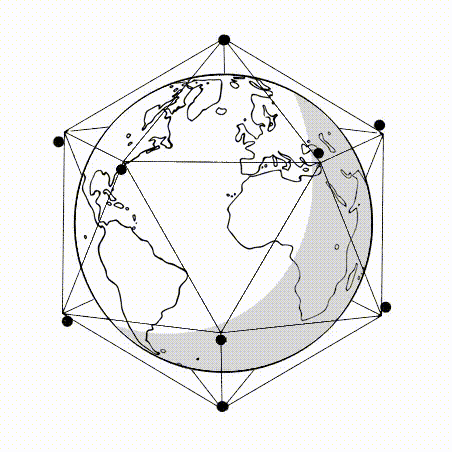ORBITATING TELESCOPE/PLANETARY
Earth orbit, 2017
Location
Earth Orbit
Promoter
Eleven Magazine
Result
Entry – International Design Competition
Year
2017
Design Team
Sergio Bianchi con Simone Fracasso, Alejandro Jorge Velazco Ramirez
The design is based on the placement of different planetariums outside the terrestrial atmosphere, around the earth’s equator, this gives the opportunity
to create an infrastructural network on a global scale that will link strategic nodes spread among the five continents.
The system will be structured on an icosahedrons geometry that will also embed places such as large-scale mines. This will aim to an environmental recovery of these areas and it will facilitate the transportation of raw materials through the implementation of the Hyperloop Transportation System between the icosahedron vertex. The constitution of such system aims also to increase the energy supply of the earth, in fact the idea is to link planetariums to the terrestrial surface with space bridges transporting people and sending the clean energy, captured beyond the atmospheric filter, back to earth.
The idea of having not only one, but multiple planetaries is based on a geometric selection of strategic view points towards the outer space surrounding the planet earth.
This choice also follows the idea of integrating a new sky mapping system that will re-creates a 360 ° view of the celestial sphere 15 times per day, offering a new tool for scientists and researchers.
On a terrestrial level the design implements a global infrastructure based on the “Hyperloop | ONE” transportation system. This network will be built with an icosahedron geometry and it will link all the five continents. For 5 of the 12 vertex, where the stations are located, we chose problematic places such as some of the biggest mines on earth (Highland Valley Copper Mine, Canada/ Carajás Mine, Brasil/ Ankleshwar Mine, India/ Mirny Mine, Russia/ Grasberg Mine, Indonesia), to environmentally recover them and to facilitate the transportation of raw materials around the planet.
The connective icosahedron on earth and the one that shapes the constellation of planetariums orbiting around the planet are linked in two ways. Human Link: the idea is to link the Hyperloop stations on earth to the planetariums through the use of re-usable space rockets such as the “SpaceX – Dragon V2” that will bring people to space.
Energy Link: the idea is to develop a new system of clean energy sending back to earth, through a wireless system developed by the Japanese Space Agency (JAXA), the 80% of the solar energy captured by the station’s photovoltaic panels.


